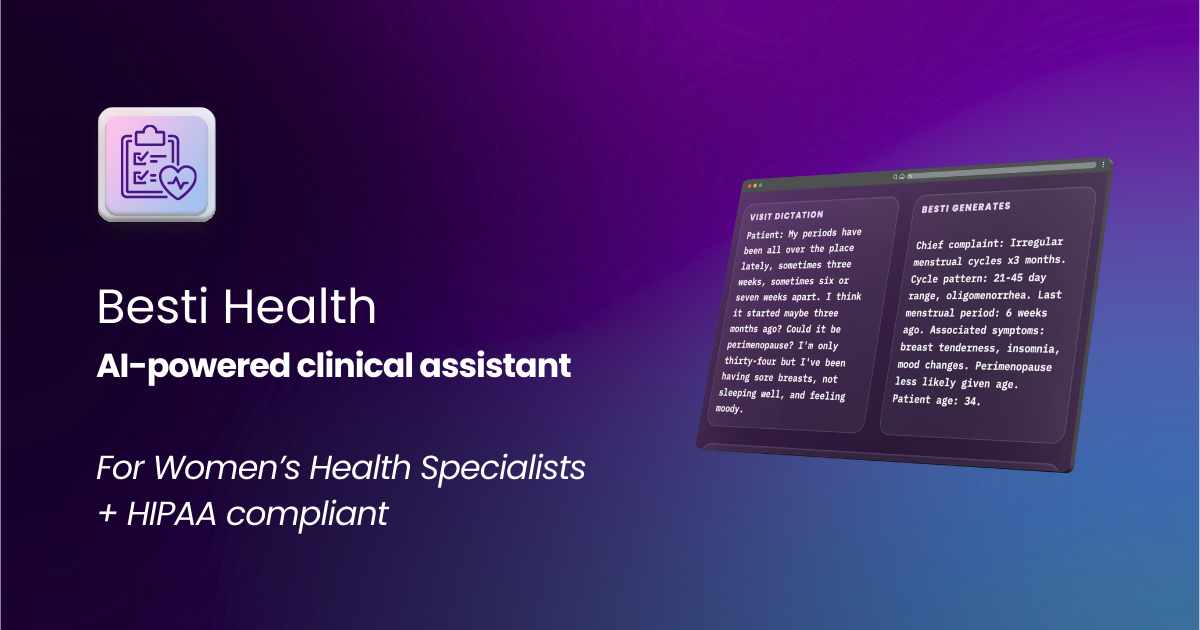Dr. Maria Santos noticed something remarkable three months after implementing AI documentation in her women's health practice. Not only was she finishing her notes faster, but her practice revenue had increased by 18%—without seeing more patients or raising fees. The secret wasn't in working harder; it was in working smarter through better documentation that captured billable opportunities she'd been missing.
If you're a women's health specialist struggling with practice profitability while managing increasing administrative demands, you're not alone. The financial pressures facing healthcare practices have never been greater, yet the solution might not be what you expect. The key to sustainable revenue growth lies not in seeing more patients, but in optimizing the value you capture from each patient encounter.
.jpg)
Traditional documentation methods in women's health practices create systematic revenue losses that most providers don't even realize are happening. Consider these common scenarios:
Incomplete Service Capture: During a routine gynecological visit, you discuss contraceptive options, perform a breast exam, provide lifestyle counseling, and address mental health concerns. But rushed documentation only captures the primary complaint, missing billable counseling and preventive services.
Undercoded Complexity: A patient presents with irregular bleeding, but the visit also involves reviewing family history, discussing fertility concerns, and coordinating care with her endocrinologist. Traditional documentation often fails to capture the full complexity level that supports higher-tier billing codes.
Lost Follow-up Opportunities: Important patient concerns get mentioned but aren't properly documented as separate issues requiring follow-up care, resulting in missed appointment scheduling and continuity revenue.
Inadequate Problem Tracking: Without comprehensive documentation of ongoing issues, practices lose opportunities for legitimate problem-focused visits that could be billed separately from routine care.Research from the American College of Obstetricians and Gynecologists suggests that the average women's health practice loses 15-25% of potential revenue through inadequate documentation and missed billing opportunities.
AI documentation systems designed for women's health don't just save time—they actively identify and capture revenue opportunities that manual documentation misses. Here's how:
Comprehensive Service Recognition: Advanced AI automatically identifies and documents all billable services provided during a visit. When you spend time counseling a patient about contraceptive options, the AI ensures this counseling is properly documented and flagged for appropriate billing codes.
Complexity Level Optimization: AI trained on women's health encounters recognizes the clinical complexity indicators that support higher-level billing codes. It automatically captures medical decision-making elements, risk factors, and care coordination activities that justify appropriate reimbursement levels.
Multi-Problem Documentation: Women's health visits often address multiple interconnected issues. AI can simultaneously track and document separate problems—hormonal concerns, reproductive health, preventive care—creating opportunities for multiple billable diagnoses when clinically appropriate.
Preventive Care Capture: AI ensures that age-appropriate screening discussions, risk assessments, and preventive counseling are consistently documented, supporting preventive care billing that's often missed in traditional documentation workflows.
.jpg)
One of the most significant financial benefits of AI documentation is increased patient capacity without compromising care quality. Here's the mathematics that's transforming practices:
Time Savings Translation: If AI documentation saves 90 minutes per day (a conservative estimate for busy women's health practices), that's equivalent to 3-4 additional patient slots daily. Over a year, this represents 750-1,000 additional patient encounters.
Faster Diagnosis and Treatment: AI's comprehensive documentation helps providers quickly identify patterns and connections between symptoms, leading to faster accurate diagnoses. Quicker diagnosis means fewer "rule-out" visits and more definitive treatment appointments.
Enhanced Care Continuity: Better documentation enables more focused follow-up visits. Instead of spending time reviewing scattered notes, providers can immediately understand patient history and focus on advancing care, creating more valuable patient interactions.
Reduced No-Shows: When patients receive comprehensive visit summaries and clear follow-up instructions (automatically generated by AI), they're more likely to attend scheduled appointments, improving practice revenue predictability.
Practices that implement intelligent AI documentation gain significant competitive advantages:
Financial Sustainability: Higher revenue per patient encounter creates financial resilience against insurance reimbursement pressures and operational cost increases.
Provider Satisfaction: When providers can see more patients without working longer hours and capture appropriate compensation for their expertise, job satisfaction increases significantly.
Patient Access: Increased practice efficiency means better appointment availability, improving patient satisfaction and practice reputation in the community.
Growth Capacity: Optimized documentation and increased efficiency create the operational foundation for practice expansion without proportional increases in administrative overhead.

Quality AI documentation systems typically cost $100-300 per provider per month—an investment that most women's health practices recover within the first 30 days through improved billing capture and increased patient capacity.
Consider the math: If AI documentation helps you see just two additional patients per week at an average revenue of $200 per visit, that's $20,800 in additional annual revenue per provider—a 700-2,000% return on investment.
The practices that thrive in healthcare's evolving landscape won't be those that simply work harder—they'll be those that work smarter through technology that amplifies their clinical expertise and business acumen.
AI documentation represents more than operational efficiency; it's a strategic tool for capturing the full financial value of the comprehensive, expert care that women's health specialists provide. In an environment where every revenue opportunity matters, can you afford to continue leaving money on the table through inadequate documentation?
The question isn't whether AI documentation will become essential for practice profitability—it's whether you'll be among the early adopters who gain competitive advantage, or wait until financial pressure forces the decision.
Your expertise deserves appropriate compensation. Your practice deserves sustainable profitability. And your patients deserve the expanded access that financially healthy practices can provide. The path forward begins with documentation technology that recognizes and captures the full value of women's health care.